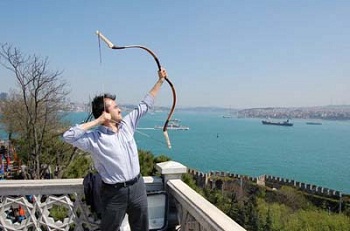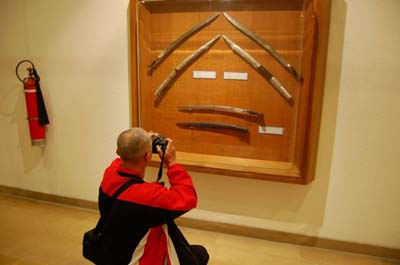In XVII th century Turkish Otoman Empire supplied South East Asian Sultanats with military aid against Dutch and Portugal colonial troops. Some of the war ships sent out from Istambul reached as far as Mindanao archipelago in the Filipines. Ships carried heavy artillery, regular troops and military advisors.
Apart from guns at that time Turkish soldier would be equipped with recurved, composite bow, the Sabre and the Yatagan. Bow and sabre was used both on horseback and on foot but yatagan would come into play at a very close distance where both hands can be use, same as in Filipino stick or Kalis sword fighting.
At the end of April this year the Gazi University in Ankara (Turkey) was a host for a special meeting-workshop on subject of reconstruction of Turkish Traditional Archery and Sabre plus Yatagan fighting technique. The Kemankes (Archery) group was a main creative force behind this event. I was invited there to give lecture on possible connection between Turkish blade and Filipino fighting technique.
Leaving Sabre and bow for now if we look closer at Yatagan and Kalis swords the similarities are obvious. Both blades are choppers, designed to strike with a chopping motion at a close distance. Their center of gravity is moved forward towards
the tip and the blade curves (drops) downwards to create strong chopping abilities. Handles are almost the same curved down towards the cutting edge.
Keeping these suggestions in mind we nmight assume that there was a significant Turkish influence in design of Filipino Kalis sword in XVII century in Mindanao area (where Kalis was born), while shorter Keris (Kris) is of Buddhist origin and most
probably came from India.
One of my Turkish friends in archery Safak Tavkul found historical drawings of Turkish Jannisaries (infantry) carrying two Yatagan blades behind the belt on the belly. It could be a significant mark of a highly ranked officer but it can also suggest Filipino - Turkish connection in using two similar blades for fighting. As I mention previously single Yatagan was used for killing at a close distance but two of them present a nice edge in confrontation with even longer weapons. All FMA practitioners know what I am talking about. When you grab a handle of either Kalis sword or Yatagan the feeling you get is precisely the same and it "calls" for a chopping motion.
If a single weapon was to be employed in a duel there is an instant need for a shield to protect "unarmed" side of the body but once we skip the duel scenario and take a look at historical drawings we will find out that Yatagan was carried along with the Sabre which might suggest its use by soldiers on foot in a very close environment with no room to swing the Saber (ship deck, city wall, crowds, etc) However it might as well been used just for killing wounded enemy soldiers once the battle is over. What
comes next then is of course "double trouble" in this case two blades used at the same time. I am not saying that the root is in
the Filipino Sinawali drill but who knows?
Yatagan gained more popularity towards the end of XVII th century all over Otoman Empire. Poland, my native land fought many wars with Turkish army and adapted most of Turkish weaponry in the process (almost like "training on the job") but not Yatagan single nor double so either there was very specific use for it or no use at all but just presentation. It is ok to carry one blade on the belly for "display" but two? When used in combat (duel scenario) two blades present superior speed over longer weapons (saber, spear,etc) plus closing and opening motion (Guntig like) adds possible defense. However getting in close to the opponent would be the key factor of this game. Both typical FMA methods (Sinawali, Guntig) described above are good for this kind of strategy. Only when fighting in a formation the whole picture would look different. For presentation at Gazi University in Ankara we used Rutano Estokada System nine angles Diagram to analyse the motion of the blade. The Diagram makes it a very simple procedure and also works with bow and arrow. When the Ottoman Turks came to the Filipines in XVII century FMA was already there deeply imbedded in native tradition. The contact and exchange of two cultures is a fact but who gained the benefits from that contact remains an open question. To sum it all up it is good to see old arts being revitalized in the land of their origin. Among them Turkish Traditional Archery, stick-club fighting Matrak ,Saber, Yatagan and more. We as the Martial Arts practitioners should keep our fingers crossed for this kind of action and whish the Turkish pioneers all the best.
Dariusz "Kaktus" Cieszynski
Rutano Estokada System
